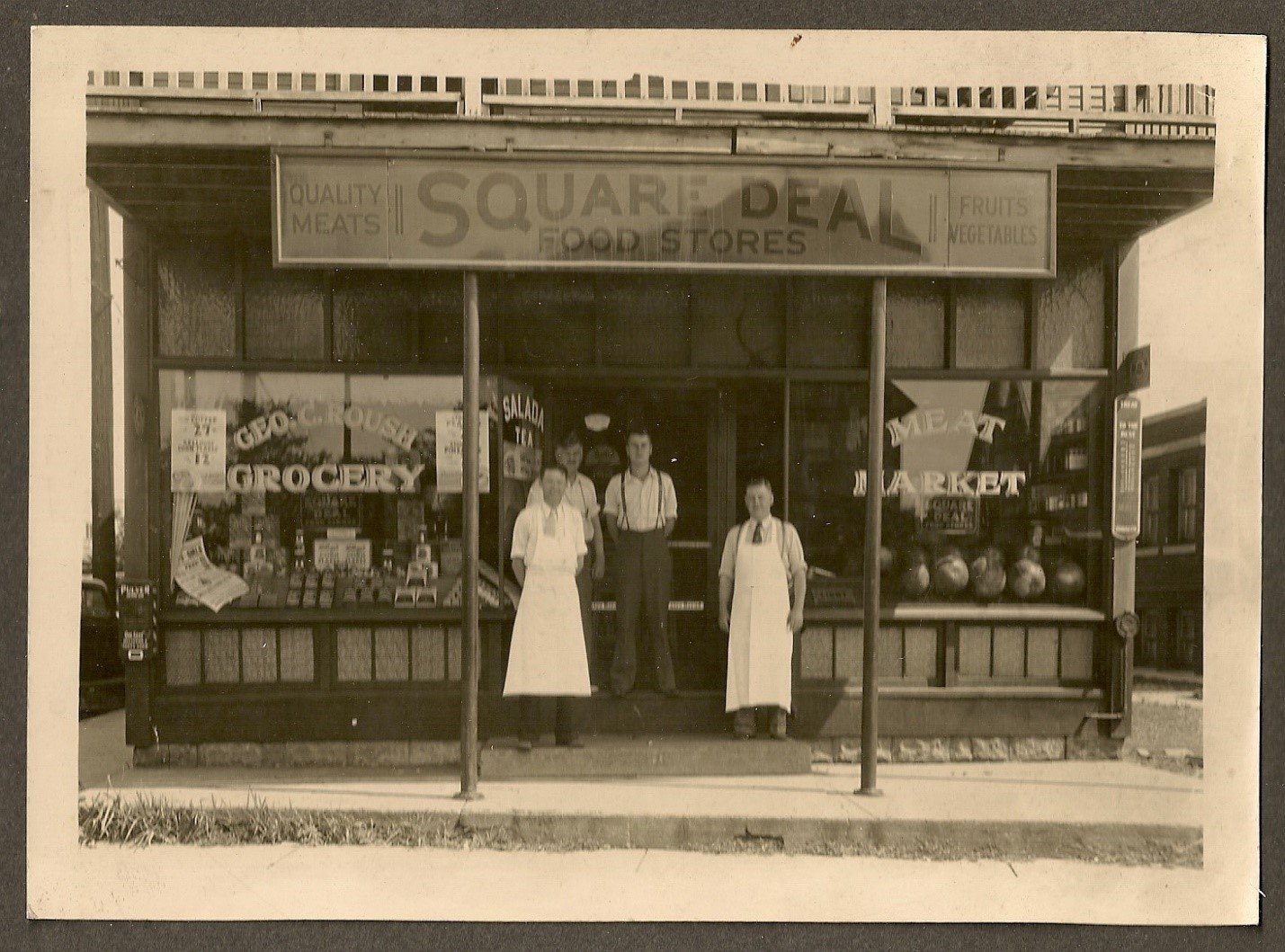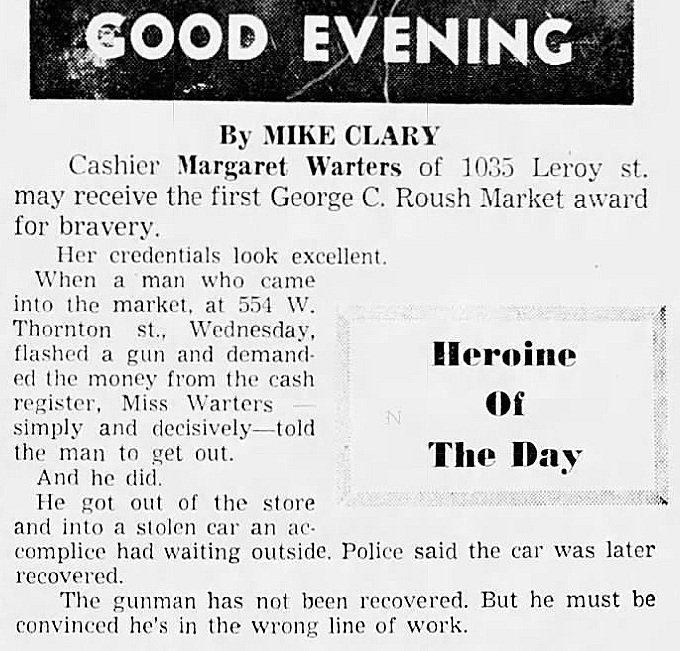
GEORGE CLYDE ROUSH
1891-1981
George Clyde Roush’s pictures and narratives were provided by his grandchildren.
Birth
Parents
-
WILLIAM DALLAS ROUSH 1844-1928
-
FRANCES M WOLF 1854-1922
Spouse
Children
-
BABY GIRL 1913-1913
-

ALBERTA MARIE ROUSH 1915-2007
-

GEORGE WILBUR 1918-2005
-

BETTY LOUISE 1921-2010
-

WILLIAM DALLAS 1929-2016
Early Years
Adulthood
World War 1
George had a strong work ethic, and became both an entrepreneur and investor. He opened his own grocery store in 1919, just one block from his father-in-law’s grocery store. George’s store did not compete with his father-in-law’s store because grocery stores sold limited products in those days. Items such as potatoes, cookies and sugar were sold in bulk. This meant that they were in large barrels, boxes, or other containers and had to be weighed and bagged for the customer. The basement of the store smelled strongly from sauerkraut that was being made in large, covered barrels. Chickens were delivered to the store live, and George and his family had to butcher them and pluck their feathers to prepare them for sale. Many immigrants lived in the neighborhood at that time, and George was able to communicate in German with those whose native language was German.

Outside of Roush's Grocery Store

Inside of Roush's Grocery Store
George was always interested in entrepreneurship and investments. In addition to his store, he invested in stocks, coal mines, and gas wells. His ownership of stock in the Morgan Belleek China Co. led to his election to the directorate of the company in 1926.
They found gas!
Morgan Belleek thrived from 1926 through 1928. The Great Depression brought the end to the company because people could not afford a high-priced luxury purchase. Morgan Belleek, in receivership by 1929, was then purchased by American Chinaware and subsequently closed. The Wall Street Crash of 1929 was financially very difficult for George. In addition to the demise of Morgan Belleek, he lost vast amounts of money due to having purchased on stocks margin.
There are many examples of Morgan Belleek china online. This picture is an example of a cup and saucer set offered for sale.
Despite the financial hit that George and Louise experienced during the Depression, their generosity flourished. He would give people “ham bones” so they could make soup. One person later told his daughter, Betty, that his family would not have survived the Depression without George’s help. George also helped his customers by extending them credit during the Great Depression. People would come to the store to purchase groceries on credit because they did not have money. George and Louise sold them the food on credit and then stored the sales receipts in boxes in the basement of the store. Eventually, 12 large cartons that had originally held packages of toilet paper were filled with the receipts. George and Louise never asked the families to repay their debts!
His first car caused a lot of excitement in the family. Louise and the children gathered in front of the house to watch George drive off in the new “contraption”. He drove around the block, and everyone waved as he approached the house. The next time he drove around the block he yelled that he didn’t know how to stop!
Between 1930 and 1940, George and Louise built a new home at 1031 Leroy Avenue, Akron, Ohio. It was a 4 bedroom, 2 story home with a large front porch, and it was a short walk to their store. The picture below shows George building the porch. After the home was completed, everyone in the family called it “The House”, even if they had their own home.
This photograph shows George building the porch of his new house.
Although the exact year is not known, while his children were still living at home, George had a heart attack. His daughter, Alberta, was very upset when she saw a full waiting room at the doctor’s office and her father was not being seen. She told the other patients that, because they were there, the doctor could not take care of her father and he was going to die. The waiting room immediately cleared of all of the other patients, and George was seen. Until he fully recovered, George crawled up the steps. The doctor told him to drink a glass of wine each day. For many years he took his daily drink of wine from the bottle of Mogen David kept in the refrigerator.
Years later, George and Louise purchased a car with a rumble seat (a car with a rumble seat is pictured below). Louise loved to tell about the time that they invited George’s brother Wilbur and his wife Mable to ride along on a trip back to Meigs County. At that time there were no interstate highways, and the roads were bad, making the trip long and bumpy. There had been heavy rains prior to this excursion, and huge potholes were so full of water that it was impossible to see them. Suddenly George hit a pothole, and Mable, who was sitting in the rumble seat, went flying out of the car and landed in the pothole. The water was so deep that she could not see her legs! She began to cry and scream that her legs were gone! Fortunately, she still had both of her legs, but it gave the family plenty of laughs for years to come.
Example of a car with a rumble seat from Pinterest
George also invested in coal mines. Chippewa Mines was incorporated on 24 Oct 1935, in Canal Fulton, OH by George and two others. At one point he took his son, George Wilbur (nicknamed Bud), to one of the mines so that he could inspect it. Telling Bud to wait outside, George went into the mine. There had been a collapse, and George at one point had to get down on his hands and knees to see what had occurred. Suddenly water began rushing into the area, and George had to rush out of the mine to save himself. Bud, knowing what had happened and seeing his father covered with coal dust and dirt, realized that he wanted nothing to do with that life. That was the day that Bud decided to go to college!
World War II had a big impact on George and Louise. The Japanese attack on Pearl Harbor occurred on December 7, 1941, causing the United States to enter the war. On February 25, 1942, their son, George Wilbur, enlisted in the army at Fort Hayes, Columbus, Ohio. During this war the United States experienced rationing of automobiles, tires, gasoline, fuel oil, coal, firewood, nylon, silk, and shoes. Americans used their ration cards and stamps to take their meager share of household staples including meat, dairy, coffee, dried fruits, jams, jellies, lard, shortening, and oils. Because ration tickets didn’t go far, he bought sides of beef on the black market by going to the farm of Al Young in Hartville, Ohio after dark. He maintained two sets of books: his personal set and one for the government.
From National Archives
George was known to donate his ration cards to families in need. Once, one of his grandsons lost one of his little shoes by throwing it out of the car window. George gave his ration ticket to his daughter to purchase a new pair of shoes.
Following World War II, George helped the people of Germany by contributing to the purchase of shoes and clothes, as shown in the thank you letter below.
George Roush was known as a kind, gentle man, but he also had a sense of humor and an excellent imagination. Harry Stewart, who delivered groceries for Roush’s Market while he was in high school, tells about the wealthy people of the west side of Akron who wanted the excellent meats from Roush’s. One day, after finishing his deliveries, Harry returned to the store where George told him that one of the customers called to complain that Harry had let a mouse into her house! George, with a twinkle in his eye and a grin on his face told Harry that he better go back and get rid of that mouse. Harry returned to the customer’s home, went into the basement, and made noise like he was looking for the mouse. Then he ran up the stairs and opened the door, yelling that he had chased the mouse out. Upon returning to the store, George asked Harry if he took care of the mouse, and Harry replied, “I sure did!” Both of them burst out in laughter.
In addition to helping those in need, George paid off the mortgages of a church in Meigs County and the Slusser Memorial Evangelical United Brethren Church on West Thornton Street, Akron, Ohio.
Slusser Memorial Evangelical United Brethren Church on West Thornton Street, Akron, Ohio.
Georges’s grandchildren also benefited from his generosity. One Christmas he gave each of them a $1000 bill, and another year he gave them shares of stock.
George and Louise purchased United Cleaners. He gave George W. “Bud” the title of president. Alberta and her husband, Coy Eugene Yerkey ran the main cleaners, Louise was vice president, and George was the Secretary and Treasurer. Besides the main building, where the cleaning was actually done, they had 4 branch stores in Akron and 2 in Cuyahoga Falls.
Ad for United Cleaners
Korean War, from 1950 through 1953, brought more stress for George and Louise when their son William Dallas served in the U.S. Army.
1954 was an exciting year for the Roush family. That was the year that George and Louise built and opened a new, larger grocery store: Roush’s Market at 554 West Thornton Street, Akron, Ohio.

Roush's Supermarket
He and Louise worked long hours at the store. The store hours were 8 to 6:30 Monday through Thursday and 8 to 8 on Friday and Saturday. George worked very hard to make his store a success. Twice a week before sunrise, George would drive to the farmer’s market on Beaver Street in Akron to buy a supply of fresh produce for the store. He didn’t have a van or truck, just a station wagon. After his purchases the vehicle would be completely full, stuffed tightly so he couldn’t see out the back on the trip back home.
He would walk home for a big lunch that Louise would make for him and any family members who would stop to eat. After lunch, he would lie down and take a nap or watch part of a Cleveland Indians game before returning to work.
George was a big fan of baseball, especially the Cleveland Indians. For many years he had 4-8 season tickets about 10 rows behind home plate. Louise would make sandwiches and everyone would pile into the car and head for the stadium. George had to use his strong interpersonal skills to calm the situation at one game when his daughter, Betty was young. Betty was upset that a man sitting in front of her was cheering for the opposing team, so she used her program to hit the man on the head! His grandson, Bob Yerkey, still remembers how much fun he had going to baseball games with “DaDo”.
Bob also loved going golfing with George. George golfed at Turkeyfoot Golf Course so frequently that the staff there called him “Professor”.
George was a terrific grocery store owner because he knew the names of all his customers, knew about their families, and greeted everyone with a big smile when he saw them in the store. He made enough money to open more stores, but then he wouldn’t get to interact with customers, he would have to spend his time managing stores. Instead, he invested his money in the stock market.
George was a wise investor and probably accumulated as much wealth as if he had opened several more grocery stores. Oddly enough, he did not invest in an consumer goods companies – the products he knew the most about.
George’s grandchildren have fond memories of visiting him at the store, where he would take a hotdog or piece of lunchmeat out of the meat case and give it to them. Trips to the ice cream stand were a treat, but Louise always had to pay because George didn’t bring any money!
George loved his grandchildren and relished telling them stories. One summer George told his granddaughters, Vicki and Susan, that they both were going to have “great cherry-picking noses”. Susan wanted to know what that meant. George told her that their noses were going to grow big and long with a hook on the end. They would be able to hold on to a branch with the hooks and use both hands to pick the cherries.
Another time Susan and Vicki were both amazed when he put a peach pit that he was holding into his ear and then pull it out of his mouth! The girls talked about how he was able to do that! Great trick, George.
July 20 1969, when George was 77 years old, the Apollo 11 Moon Landing occurred. During his lifetime the world had gone from horses and wagons to the development of the Model T and the Wright Brothers flight (1903) to the moon landing!
As the neighborhood declined, crime increased. After George was robbed carring the money from the store back to his house (a short walk away), his response was to buy a gun and learn how to use it. He would make the walk back and forth to the store, morning and night, with the gun drawn, ready to fire. When his granddaughter, Patricia Roush, was about five years old, she was walking from the store with “DaDo” when she asked him if she could carry the gun. George said, “Sure,” and handed it to her, but as they approached “the house” he asked her to give it back to him so that Louise would not find out.
The store was robbed many times over the years, and examples this are illustrated in the following articles:

Courtesy Akron Beacon Journal, July 8, 1965

Courtesy Akron Beacon Journal July 30, 1969
In April, 1972, he and Louise sold the store and purchased a home in Randolph, Ohio, across the street from his daughter, Alberta. Louise passed away the following year.
While living in Randolph, George continued with his desire to be active by walking the mile from his home to the crossroads that was the center of the township and back. If the weather was poor, he remained at home and rode his stationary bike. He continued this into his late 80s.
George was always very sensible with this money. As an old man, he refused to go when Alberta told him that she was taking him to buy a new pair of shoes. He said that he didn’t need new shoes because he was not going to live long enough to wear them out!
While living in Randolph, he suffered carbon monoxide poisoning and had to be admitted to a nursing home. After leaving the nursing home he stayed with Alberta and then Bud.
George was admitted to the hospital once again. He was diagnosed with Idiopathic thrombocytopenic purpura (ITP), a rare blood disorder, and was then transferred to ManorCare Nursing Home where he died at the age of 89, on June 14, 1981. He was buried in Rose Hill Cemetery beside Louise.













